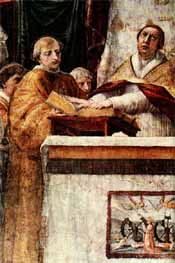Cleaning oath

The cleansing oath ( Latin juramentum purgatorium ) is a procedural element of jurisdiction from the early and high Middle Ages that goes back to Celtic and Germanic legal culture , according to which the untruth of an alleged fact is sworn by an oath if the evidence is incomplete . A well-known cleansing oath was the declaration that Pope Leo III. on December 23, 800 in front of Charlemagne and other dignitaries.
The cleansing oath was imposed on a defendant in order to give him the opportunity to "wash himself clean" of a charge of guilt by taking the oath or to testify of his innocence . Usually was in the oath for affirmation God called and a sacred object by its physical contact sworn , and in particular a copy of the Bible , a oath cross or a relic . There was also a given formula of the oath . Only if the defendant "succeeded" in taking the cleansing oath through error-free verbal reproduction of the oath formula, he was considered innocent, otherwise he was convicted. This could sometimes fail. Even the mere promise or muddle when repeating the oath imposed by the court was considered a confession of guilt .
The practice of the cleansing oath was based on the conviction that supernatural powers in particular would intervene immediately in the event of an attempted perjury and let the oath fail (→ judgment of God ). It could also happen that the accused not been granted the right to clean silk, namely, when he red-handed in the act had been found, a fact that one in medieval Procedure "in hand-like action" called. In this special case, the so-called hand detention procedure , the plaintiff was allowed to pronounce an oath of indictment, which - if it succeeded - automatically found the accused guilty.
Sometimes it also happened that relatives had to assist the accused in swearing the cleaning oath . Strangers who had no close relatives or who could not provide an oath, had to submit to a divine judgment, such as B. walking over glowing coals or wearing a glowing horseshoe, whereby no branding was allowed. In the late Middle Ages, however, under the influence of the Church, the divine judgments that had been adopted in principle from pagan times disappeared more and more.
Towards the end of the Middle Ages, the oath of cleansing slowly lost its importance. In its place came the conviction of the accused through the testimony of two credible witnesses , the " evidence ", or through the confession of the accused, the " original gout ", which was often extorted through an " embarrassing questioning ".
literature
- Richard Loening: The cleaning oath in unjudicial actions in the German Middle Ages , Carl Winter's university bookstore, Heidelberg, 1880
Individual evidence
- ^ Article cleaning oath , Herders Conversations-Lexikon, Freiburg im Breisgau, 1856, p. 697, accessed on the zeno.org portal on April 21, 2013
- ↑ Gerhard Müller (Ed.): Theologische Realenzyklopädie . Verlag Walter de Gruyter, New York, Berlin, 1993, ISBN 3-11-013898-0 , p. 384
